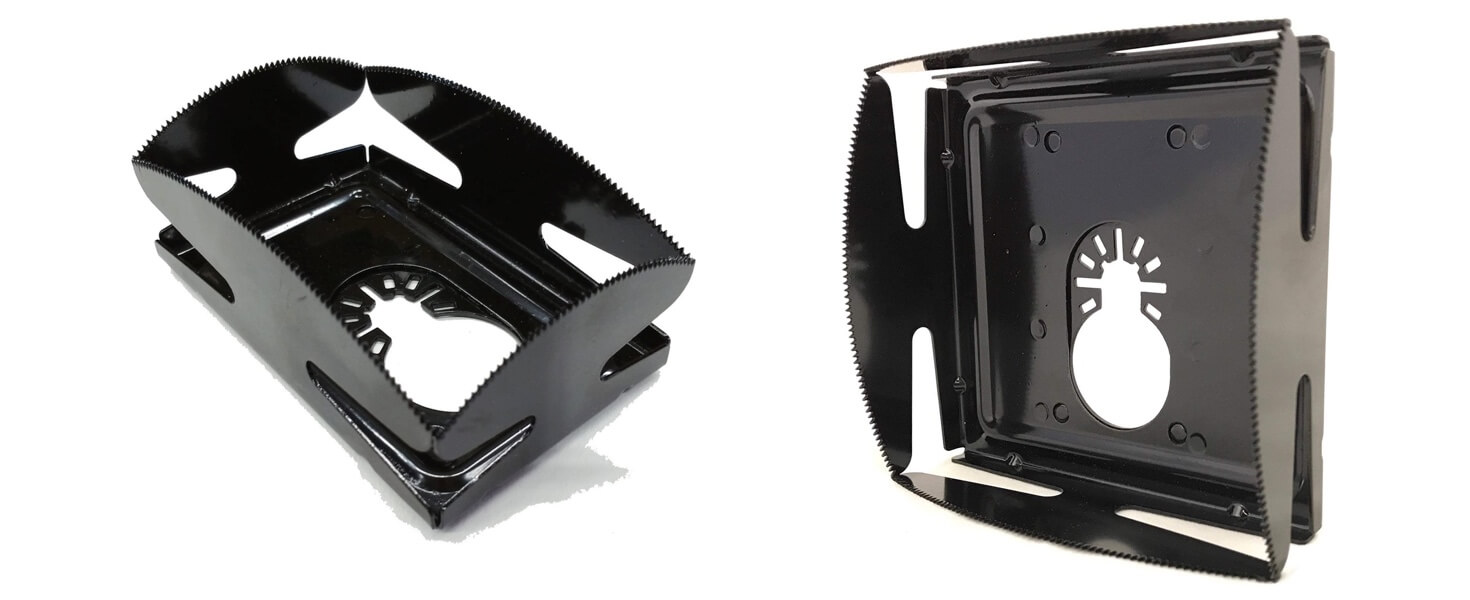The different types of oscillating tool blades
An oscillating tool can be extremely versatile. Learn more about the different blades and their general purpose.
An oscillating tool can be extremely versatile. Learn more about the different blades and their general purpose.

We recently talked about the DeWalt Oscillating tool and how every DIY’er should own one! It’s such a versatile tool that can tackle many projects and make your DIY life much easier. But an important part of this tool is the blade attachments.
I’ve been using the plunge cutter wood blade that came with the tool kit for roughly 4 months. I’ve cut anything from 2×4’s to paneling and dry-wall with it. And it still performs like it did on day one.
But while this one blade may work for different applications, it isn’t necessarily best. And that’s exactly what we’ll be talking about today—the different types and uses of oscillating tool blades.
Oscillating tool blades come in all different shapes, sizes, materials, and uses. We’ve collected the most common blades and a unique one that may surprise you!

Fine tooth blades come in different sizes. A few common sizes are 3/8″, 3/4″, 1″ and 1 3/8″. While they can cut both wood and metal, you’ll want to check what the blade is meant to cut. The blade will typically display wood, bi-metal, or metal.
These types of blades are mainly used for precise cuts. For this reason, they usually have a measuring strip on one or both sides of the blade. This eliminates any guesswork on how deep you’re cutting.

These blades share many of the same characteristics as fine tooth blades. What sets them apart is that they provide a wider cut. They offer a wider cutting blade, which proves useful when you don’t need to be as precise, and you need to cut wide/deep cuts.
Tip: If you have a lot of material to cut, such as drywall or paneling, a plunge cut blade will speed up the process. Since they are not as precise, however, it’s recommended to use a guide. You could tape a yardstick where you need the cut, for example, and use that to guide your blade.

Segment saw blades are ideal to cut a lot, in a small amount of time. The blades are usually 3 1/8″ wide. This type of blade can cut anything from drywall to 2×4’s and 4×4’s.
Why not use a circular saw, then? Because with a segment saw blade on an oscillating tool, you can make plunge cuts. A plunge cut allows you to start cutting material, without having to start cutting from an edge. For example, you could cut out a 1 x 1 foot square in a drywall wall without a problem.

Have you ever had to remove old caulk, silicone, adhesive, or other nasty stuff? Depending on how long it’s been there, it can prove virtually impossible to remove.
That’s where scraper blades come in. It combines the versatility of the oscillating tool, without the ability to cut. Instead, it’ll scrape away whatever you put it on, in record time!

One of the benefits the oscillating tool provides is that it doubles as a sander. While I use my 20v battery-powered DeWalt Oscillating tool as a sander quite often, I would not recommend it for big sanding jobs. It’s handy for quick sanding purposes, like burs off of a newly cut board. Since the universal arbor on oscillating tools, switching from saw blade to sanding attachment takes just seconds.

Carbide blades are very tough and durable. If you want to remove grout, or even cut brick, cement, or concrete, a carbide blade is what you need. But these tough blades aren’t just for tough jobs.
You can even get carbide fine-tooth or plunge cut blades for woodworking. While they cost a bit more, you’ll be happy to know they also last 10 to 20 times longer than steel blades! That, and they provide excellent cuts.

While you can use a fine-tooth, plunge cut or even segment saw blade on your oscillating tool to cut drywall, there are specialty blades made just for that purpose!
They come in various styles and price-points, each providing their own unique way to improve cutting drywall. We feel the 4 in 1 drywall blade is a must-have if you cut drywall often.

Nothing makes cutting outlet boxes out of paneling or drywall easier than this specialty oscillating tool. Specifically designed for one purpose, cutting an outlet box. No measuring or marking required! Place the single or double outlet box cutter where desired, make sure it’s level, and start cutting.
It’s by far the most expensive single oscillating tool blade on our list. But as a handyman or professional, what’s $60-$100 to save yourself precious time over and over again?
See the outlet cutter here, available in single and double outlet.
On oscillating tool is extremely versatile due to its acceptance of various attachments.
This is by far the biggest use of the oscillating tool. If you buy an oscillating tool, chances are you have something specific in mind you want to saw. You can use a wood blade for sawing multiple materials, such as wood, paneling, and drywall. But you’ll always get the most of your tool if you use the right blade for a specific material.
While an oscillating tool is great for cutting and sawing material, it also doubles as a sander. I still use my corded DeWalt sander for big sanding jobs. But I love using my 20v battery-operated DeWalt Oscillating tool for quick sanding purposes. No need to dig up the extension cord. Just pop on the sanding attachment and get it done.
Depending on the sanding attachment, sanding pads are available in circular and triangle shapes. I personally prefer the triangle shapes as the corners allow me to get in tough-to-reach spots.
If you’re doing some tile work, like a bathroom renovation, you may have to remove the old grout. The oscillating tool can make quick work of that. The grout removal blades come in both carbide and diamond edges. For most applications, the Carbide edged blades will do the trick, such as tile joints, grout, or even concrete.
The diamond edge blades are more expensive, but they get the job done faster, and they will last much longer.
A less popular use of the oscillating tool is to cut material. Most oscillating cutting blades are designed for soft materials. Such materials include leather, felt, rubber, carpet, and so on. Even if you never plan on cutting such materials, having a cutting blade can come in useful for removing old caulk. It’s a nasty job that can otherwise take a long time with a utility knife.
Carbide oscillating tool rasps are great for coarse sanding. Think tile adhesive, wood, fillers, concrete, or even stone. These rasping attachments are available in round, triangular, and finger shapes.
Have you ever pulled up old vinyl flooring only to end up with large patches and glue stuck to your floor? This is just an example of when a scraper blade really comes in handy. It will remove this stuff with ease, and you don’t have to worry about cutting your floor by accident. These scaper blades come in both rigid and flexible. Other uses include removing adhesive, tile, carpet, silicone, glue, and paint.
If you’re a crafty individual that likes working with metals, you’ll be glad to know that your oscillating tool can make your polish work much easier. Pads are available in different densities, just like sanding pads. They can provide a beautiful polished finish on chrome, stainless steel, aluminum, and other materials.
Want to know more uses of oscillating tools? See 12 uses of an oscillating tool for DIY’ers and professionals alike.
A diamond saw blade falls under the carbide blade category. Carbide is basically the rough texture on a tool bit to enhance the quality and durability. While carbide is typically made from tungsten, a diamond carbide bit contains, you guessed it, diamond! The rough texture contains diamond segments, which are made by combining synthetic diamond crystals with metal powder, which is then heated and compressed.
If you’re a serious craftsman, diamond carbide blades are a must-have. Not only can they tackle tougher jobs, but they also last longer than regular metal blades, and they provide a higher quality cut.

Most definitely. A wet tile saw would still be recommended, just because it’s much faster and easier to cut tiles straight. But an oscillating tool can prove useful on tile projects in a few ways:
So is an oscillating tool recommend to start your tile project? Probably not. But that doesn’t mean that it wouldn’t come in handy. And, if it’s the tool you already have at hand and only need a few tiles to cut, you can probably get away with using it as your main tile cutter.

If you’re shopping for oscillating tool blades, you’ll see blades from multiple manufacturers. A single blade can range from just a few bucks to close to $30. So you may be wondering, will this blade fit my oscillating tool? That depends on the arbor.
Most oscillating tools feature a universal arbor. If you own an oscillating tool from DeWalt, Craftsman, Skill, and a dozen of other manufacturers, it will most likely have a universal arbor. That’s great because universal arbor blades are widely available and affordable. That’s because they’re mass-produced. Rather than being manufactured by just one or two companies.

It’s good to know that diamond edge blades are faster at getting the job done. Time is money for me in my life of work. So I might get some diamond edge blades so I can make more money.
Hey Chance!
No argument there. If time is money, and you can cut time spent on a project in half by spending a bit more on quality blades, why wouldn’t you?
Best of luck with your projects.
Hi, I’m a 51 year old woman in the UK who was gifted a multitool for Christmas. I do bits of DIY when needed as hubby is not into diy! The article explained the blades so well, I’m feeling less worried about starting my next project now I know how to use them. Many thanks
Hey Samantha
That’s wonderful to hear! Thank you for the lovely comment.
This article is a fantastic resource for anyone who is looking to buy oscillating tool blades. You provide clear and concise information for readers who want to make an informed purchase, as well as attaching videos and images to make it easier for reader comprehension. Thank you for writing this article!
I just purchased a Hart oscillating multi tool ( the Walmart brand). Does it have a universal arbor, I wonder?
Hey Wade, the hart oscillating tool is indeed universal!
Hi Ben
Can you tell me if a Dobetter tool is universal. I am new to this tool. I purchased a lower priced model to start with
Yes! The Dobetter oscillating tool features an universal arbor, just like more expensive brands including Dewalt. This allows you to use a wide variety of universal oscillating tool attachments.